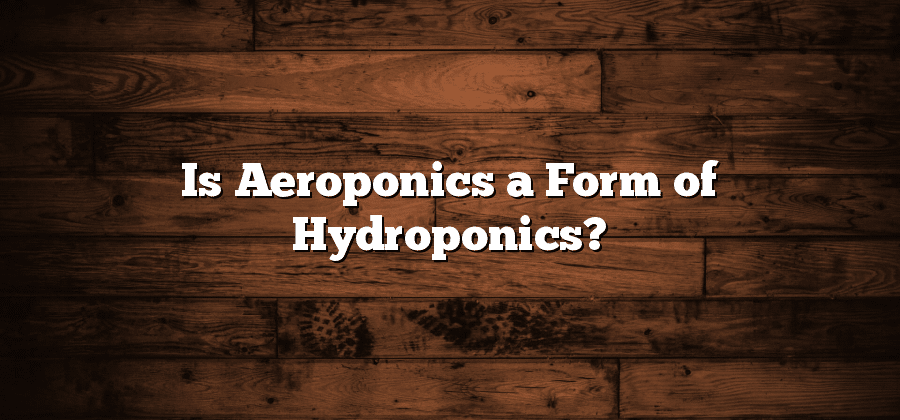Key Similarities Between Aeroponics and Hydroponics
Aeroponics and hydroponics share several key similarities in terms of their fundamental principles and goals. Both systems are soilless methods of growing plants, relying on the careful provision of essential nutrients and water to promote optimal growth. Additionally, both aeroponics and hydroponics are designed to maximize resource efficiency by providing plants with precisely measured amounts of nutrients, eliminating the wastage commonly associated with traditional soil-based cultivation.
Furthermore, both aeroponics and hydroponics offer precise control over environmental factors such as temperature, humidity, and light intensity. This level of control enables growers to create and maintain ideal growing conditions for their plants, ensuring consistently high yields and optimal plant health. Moreover, by eliminating the need for soil, both aeroponics and hydroponics reduce the risk of soil-borne diseases and pests, leading to healthier crops and minimal pesticide use.
Distinctive Features of Aeroponics
Distinctive Features of Aeroponics:
With its innovative approach to plant cultivation, aeroponics offers several distinctive features that set it apart from other growing techniques. One of the primary characteristics of aeroponics is the absence of any growing medium. Unlike hydroponics, which relies on water or an inert substrate to support plant roots, aeroponics suspends plant roots in air and delivers nutrients through a fine mist. This unique feature ensures optimal oxygenation for the roots, promoting healthy growth and product development.
Another distinctive feature of aeroponics is its flexibility in terms of space utilization. As aeroponic systems require minimal physical infrastructure, they can be easily implemented in a variety of settings, even where space is limited. This makes aeroponics an ideal choice for urban farming or indoor gardening, enabling growers to maximize productivity in constrained environments. With its emphasis on efficiency and adaptability, aeroponics represents a cutting-edge and forward-thinking approach to modern agriculture.
Unique Aspects of Hydroponics
Hydroponics is a modern agricultural technique that offers several unique aspects compared to traditional soil-based cultivation. One of the key unique features of hydroponics is its efficient use of water. Unlike traditional farming, hydroponics uses a recirculating system that significantly reduces water consumption. By utilizing a closed-loop irrigation system, hydroponic setups minimize water waste and ensure that plants receive the precise amount of hydration they need. This not only conserves a scarce resource but also allows for the cultivation of crops in areas where water availability is limited.
In addition to water efficiency, hydroponics also offers precise control over nutrient delivery. In soil-based farming, plant roots need to search for nutrients in the soil, which can be unevenly distributed. However, hydroponics eliminates this problem by directly delivering a nutrient-rich solution to the plants. This ensures that plants receive the exact amount and balance of nutrients they require for optimal growth. The ability to fine-tune nutrient delivery in hydroponics allows farmers to adjust the nutrient composition based on specific crop requirements, resulting in healthier and more productive plants.
Nutrient Delivery Systems in Aeroponics
Aeroponics, an innovative technology in the field of agriculture, relies on a well-designed nutrient delivery system to ensure optimal plant growth. Unlike traditional farming methods, aeroponics delivers nutrients directly to the plant roots without the use of soil or a growing medium. This is achieved by misting the plant roots with a highly oxygenated nutrient solution, allowing them to absorb the essential elements they need for growth.
One key aspect of nutrient delivery systems in aeroponics is the misting or fogging mechanism used to disperse the nutrient solution. This mechanism aids in the production of tiny water droplets that create a fine mist around the roots. By creating a fog-like environment, the nutrient solution is able to envelop the roots, maximizing nutrient absorption. Additionally, the misting mechanism helps to ensure that each plant receives an equal amount of nutrients, promoting consistent and uniform growth across the entire crop.
Nutrient Delivery Systems in Hydroponics
In hydroponics, the method of delivering nutrients to the plants is a critical aspect of the system. Unlike traditional soil-based cultivation, hydroponics relies on a precise and controlled supply of nutrients directly to the roots. This ensures that the plants receive the necessary elements in the right proportions for optimal growth and development.
One commonly used nutrient delivery system in hydroponics is the drip irrigation method. This method involves the use of emitters or drippers that deliver a regulated flow of nutrient solution to the plants. The drippers are strategically placed near the roots, allowing the solution to slowly drip onto the growing medium. This not only provides the plants with a constant supply of nutrients but also ensures that there is sufficient oxygenation of the root system. Drip irrigation is efficient and allows for individualized control of nutrient supply to different plants or sections of a hydroponic system.






